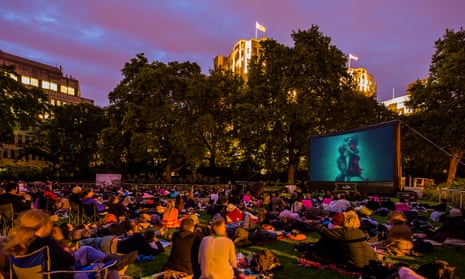Britain is in the middle of a boom in outdoor cinema, as people brave the unpredictable British climate to watch films “on location” in castles, aircraft hangars and even beach huts.
George Wood, founder of Britain’s biggest outdoor film company, the Luna Cinema, says ticket sales have tripled in the past three years. “You strike gold when you can actually pair the film to the venue,” said Wood.
Luna has shown Gladiator in the grounds of a medieval castle, Jaws at an outdoor swimming pool and Top Gun under the wings of RAF fighter aircraft. “It adds a whole other dimension to a film you might have seen 15 times before,” Wood says.
Luna now plans to take giant 10 metre-wide screens to nearly 70 venues across Britain, three times the number visited five years ago. They will be erected in places ranging from Brighton beach to the Royal Botanic Garden in Edinburgh.
A former actor, Wood set up his company a decade ago, initially as a hobby to tide him through the summer when acting jobs were scarce.
“I’d been to Australia and seen an open-air screen out there and thought: what a brilliant idea. I remember saying to my Aussie mates, why don’t we do this in England? And they all said, at the same time, ‘because your weather’s shit, mate’!”
Undeterred, Wood hired a small screen and showed Some Like it Hot at Dulwich Park in south London. To everyone’s surprise – not least the council that gave him the permit – 500 people turned up to watch Tony Curtis woo Marilyn Monroe.
Wood, who only days before had broken his leg in a moped accident, says he was hobbling around on crutches and thinking, “My God, this is it, this is what I’m going to do.”
He says: “People thought that open-air cinema would be a fad, just one of those London things that wouldn’t transfer elsewhere. Actually, it’s the provinces that have been the real success story. It turns out that people in Lincoln love Top Gun as much as anyone in London.”
David Cox, programmer for the Film4 summer screen season at Somerset House in central London, insists outdoor cinema is much more than just singalongs and crowd-pleasers.
His “dreams”-themed summer programme includes David Lynch’s Blue Velvet and Christopher Nolan’s Inception, but such is the demand for the outdoor “live cinema experience”, as he calls it, that he expects to fill the 2,000-capacity courtyard every night.
And it is not just Hollywood films on offer. Thanks to new hi-tech LED screens that work under direct sunlight, events such as Wimbledon, the football World Cup and the royal wedding will also be streamed live and alfresco.
The phenomenon has also opened up the lucrative children’s market, with a series of daytime family programming planned for this year, featuring films such as Paddington 2 and Coco.
Richard Cope, a trends expert at Mintel, thinks the booming popularity of outdoor cinema is because people are hankering for “old-fashioned communal viewing experiences”. He says: “It’s the American drive-in concept but done in a modern guise. People are so used to consuming media on their phones and iPads, there’s a natural craving for this kind of decompressed experience – where there’s loads of space, where you can react together, where you’re not just watching something on your own and tweeting about it.”
Cope believes outdoor cinema works well for musicals and “scary” films, where groups of friends can chat and drink while watching. But the constant hum can be a “massive distraction” for arthouse movies, such as Blade Runner.
“If you think about it,” says Cox, “it’s quite a vulnerable situation to be in. You don’t know what the weather’s going to do, there are no armrests to separate you from whoever you’re sitting next to, so people are putting their trust in each other – I think that makes them even more susceptible to watching a film and feeling it in a deeper way.
“And then there is the beauty of being outside on a summer’s night. It’s a very different experience from what people might expect.”

Comments (…)
Sign in or create your Guardian account to join the discussion